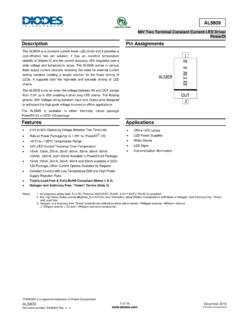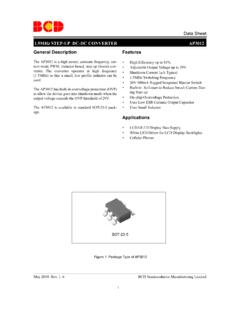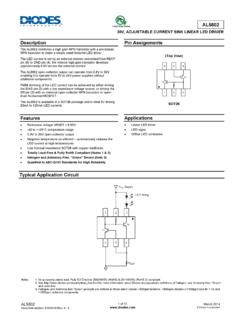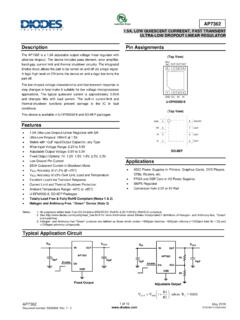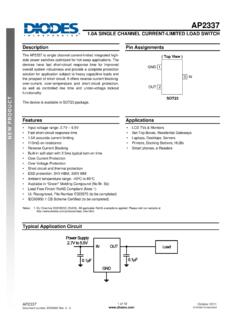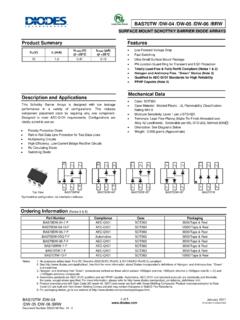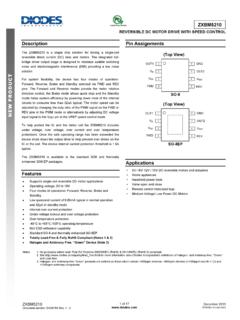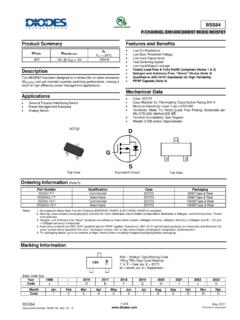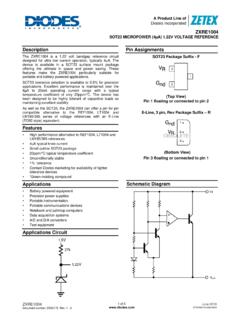Transcription of AP5100 - Diodes Incorporated
1 STEP-DOWN CONVERTER with SWITCHING FREQUENCY AP5100 Document number: DS32130 Rev. 3 - 2 1 of 12 April 2012 Diodes Incorporated Description The AP5100 is a current mode step-down converter with a built-in power MOSFET to enable smallest solution size power conversion. With the low series resistance power switch it enables a constant output current of up to over a wide input supply range. The load and line regulation has excellent response time over the operating input voltage and temperature range. The AP5100 is self protected, through a cycle-by-cycle current limiting algorithm and an on chip thermal protection. The AP5100 will provide the voltage conversion with a low count of widely available standard external components. The AP5100 is available in SOT26 package. Pin Assignments 123746 ENGNDINFBSOT265 BST( Top View )SW Features VIN to 24V Load current of up to Internal Power MOSFET Stable with Low ESR Ceramic Output Capacitors Up to 90% Efficiency A Shutdown Mode Fixed Frequency Thermal Shutdown Cycle-by-Cycle Over Current Protection Resistor divider adjustable Output: to 15V SOT26: Available in Green Molding Compound (No Br, Sb) Lead Free Finish/RoHS Compliant (Note 1) Applications Distributed Power Systems Battery Charger Pre-Regulator for Linear Regulators WLED drivers Notes: 1.
2 EU Directive 2002/95/EC (RoHS). All applicable RoHS exemptions applied. Please visit our website at Typical Application Circuit Figure 2. Typical Application Circuit CURRENT (A)Fig. 1 Efficiency vs. Load CurrentEFFICIENCY (%)100908070605040V = 12VL = HINV = 5 VOUTV = STEP-DOWN CONVERTER with SWITCHING FREQUENCY AP5100 Document number: DS32130 Rev. 3 - 2 2 of 12 April 2012 Diodes Incorporated Typical Application Circuit (cont.) BSTSWFBINENC222 HC110 F25 VONOFFC6100pF54163L1 Figure 3. , Output at 1A Step-Down Converter BSTSWFBINENC210 F16VR3100 KohmAP5100R240 ohm1%1N5819HW-7 GNDVINC310nFL110 HC110 F25 VONOFF541636V -12V- Vout-Vout- Vout-VoutLED1 LED 2 LED 3R4200 Kohm1%D1 Figure 4. white LED Driver Application STEP-DOWN CONVERTER with SWITCHING FREQUENCY AP5100 Document number: DS32130 Rev. 3 - 2 3 of 12 April 2012 Diodes Incorporated Pin Descriptions Pin Name Pin # Description BST 1 Bootstrap.
3 To form a boost circuit, a capacitor is connected between SW and BST pins to form a floating supply across the power switch driver. This capacitor is needed to drive the power switch s gate above the supply voltage. Typical values for CBST range from F to 1 F. GND 2 Ground. This pin is the voltage reference for the regulated output voltage. All control circuits are referenced to this pin. For this reason care must be taken in its layout. FB 3 Feedback. To set the output voltage, connect this pin to the output resistor divider or directly to VOUT. To prevent current limit run away during a current limit condition, the frequency foldback comparator lowers the oscillator frequency when the FB voltage is below 400mV. EN 4 On/Off Control Input. Do not leave this pin floating. To turn the device ON, pull EN above and to turn it off pull below If enable/disable is not used, connect a 100k resistor between EN to VIN.
4 IN 5 Supply Voltage. The AP5100 operates from a + to +24V unregulated input. A decoupling capacitor C1 is required to prevent large voltage spikes from appearing at the input. Place this capacitor near the IC. SW 6 Switch Output. This is the reference for the floating top gate driver. Functional Block Diagram Figure 5. Functional Block Diagram STEP-DOWN CONVERTER with SWITCHING FREQUENCY AP5100 Document number: DS32130 Rev. 3 - 2 4 of 12 April 2012 Diodes Incorporated Absolute Maximum Ratings (Note 2) Symbol Description Rating Unit ESD HBM Human Body Model ESD Protection 3 KV ESD MM Machine Model ESD Protection 300 V VIN Supply Voltage 26 V VSW Switch Voltage to VIN + V VBST boost Voltage VSW +6 V All Other Pins to +6 V TST Storage Temperature -65 to +150 C TJ Junction Temperature +150 C TL Lead Temperature +260 C JA Junction to Ambient Thermal Resistance (Note 3) 140 C/W JC Junction to Case Thermal Resistance (Note 3) 35 C/W Notes: 2.
5 Exceeding these ratings may damage the device. 3. Test condition for SOT26: Measured on approximately 1 square of 1 oz copper. Recommended Operating Conditions (Note 4) Symbol Description Rating Unit VIN Supply Voltage to 24 C TA Operating Ambient Temperature Range -25 to +85 C VOUT Output Voltage to 15 V Note: 4. The device function is not guaranteed outside of the recommended operating conditions. STEP-DOWN CONVERTER with SWITCHING FREQUENCY AP5100 Document number: DS32130 Rev. 3 - 2 5 of 12 April 2012 Diodes Incorporated Electrical Characteristics (VIN = 12V, TA = +25 C, unless otherwise noted) Note: 5. Guaranteed by design. Symbol Parameter Test Conditions Min Typ. Max Unit VFB Feedback Voltage VIN 24V V IFB Feedback Current VFB = A RDS(ON) Switch-On Resistance (Note 5) Switch Leakage VEN = 0V, VSW = 0V 10 A Current Limit (Note 5) A fSW Oscillator Frequency VFB = MHz Fold-back Frequency VFB = 0V 480 kHz Maximum Duty Cycle VFB = 87 % tON Minimum On-Time (Note 5)
6 100 ns Under Voltage Lockout Threshold Rising V Under Voltage Lockout Threshold Hysteresis 150 mV EN Input Low Voltage V EN Input High Voltage V EN Input Current VEN = 2V A VEN = 0V IS Supply Current (Shutdown) VEN = 0V A IQ Supply Current (Quiescent) VEN = 2V, VFB = 1V mA Thermal Shutdown (Note 5) 140 C AP5100 Document number Typical PeVIN = 12V, VOU r: DS32130 Rev.
7 3 erformanceUT = , L = 3 Stead(IOTimStart-up T(NTimShutdown(NTim- 2 e H, C1 = 10dy State Test UT = ) me- 1 s/div Through EnabNo Load) e- 50 s/div n Through EnaNo Load) e- 50 s/div STE weristics 0 F, C2 = 22 Fble able EP-DOWN C6 of , TA = +25 C, CONVERT m unless otherwLo(IOUT= (IOUTS hutd(IOUTTER with noted. oad Transient2A to SteTime- 100 s/d rt-up through T= 1A, resistivTime- 50 s/d down ThroughT= 1A, resistivTime- 50 s/dAP4 MHz SWIFREQ Diot Test ep at s)div Enable ve load) div h Enableve load) div P5100 TCHING QUENCY April 2012 odes Incorporated STEP-DOWN CONVERTER with SWITCHING FREQUENCY AP5100 Document number: DS32130 Rev. 3 - 2 7 of 12 April 2012 Diodes Incorporated Typical Performance Characteristics (cont.) Short Circuit Entry Short Circuit Recovery Time- 50 s/div Time- 100 s/div Applications Information OPERATION The AP5100 is a current mode control, asynchronous buck regulator.
8 Current mode control assures excellent line and load regulation and a wide loop bandwidth for fast response to load transients. Figure. 4 depicts the functional block diagram of AP5100 . The operation of one switching cycle can be explained as follows. At the beginning of each cycle, HS (high-side) MOSFET is off. The EA output voltage is higher than the current sense amplifier output, and the current comparator s output is low. The rising edge of the oscillator clock signal sets the RS Flip-Flop. Its output turns on HS MOSFET. When the HS MOSFET is on, inductor current starts to increase. The Current Sense Amplifier senses and amplifies the inductor current. Since the current mode control is subject to sub-harmonic oscillations that peak at half the switching frequency, Ramp slope compensation is utilized.
9 This will help to stabilize the power supply. This Ramp compensation is summed to the Current Sense Amplifier output and compared to the Error Amplifier output by the PWM Comparator. When the sum of the Current Sense Amplifier output and the Slope Compensation signal exceeds the EA output voltage, the RS Flip-Flop is reset and HS MOSFET is turned off. The external Schottky rectifier diode (D1) conducts the inductor current. For one whole cycle, if the sum of the Current Sense Amplifier output and the Slope Compensation signal does not exceed the EA output, then the falling edge of the oscillator clock resets the Flip-Flop. The output of the Error Amplifier increases when feedback voltage (VFB) is lower than the reference voltage of This also increases the inductor current as it is proportional to the EA voltage.
10 Setting the Output Voltage The output voltage can be adjusted from to 15V using an external resistor divider. Table 1 shows a list of resistor selection for common output voltages. Resistor R1 is selected based on a design tradeoff between efficiency and output voltage accuracy. For high values of R1 there is less current consumption in the feedback network. However the trade off is output voltage accuracy due to the bias current in the error amplifier. R2 can be determined by the following equation: = Equation 1 VOUT (V) R1 (k ) R2 (k ) (1%) (1%) (1%) (1%) (1%) (1%) 5 (1%) (1%) Table 1. Resistor Selection for Common Output Voltages SWfL IINV)OUTVIN(VOUTVL = Equation 2 Where IL is the inductor ripple current. And fSW is the buck converter switching frequency. STEP-DOWN CONVERTER with SWITCHING FREQUENCY AP5100 Document number: DS32130 Rev.
